Attached files
| file | filename |
|---|---|
| EX-10.1 - KCPL RECEIVABLES SALE AGREEMENT AMENDMENT - KANSAS CITY POWER & LIGHT CO | ex10_1.htm |
| 8-K - FORM 8-K INVESTOR DECK AND KCPL RECEIVABLES AGMT. - KANSAS CITY POWER & LIGHT CO | f8kirdeck_kcplrec.htm |

September 2011 Investor Presentation
Great Plains Energy
Investor Presentation
September 2011
Exhibit 99.1

2
September 2011 Investor Presentation
Forward-Looking Statement
Statements made in this presentation that are not based on historical facts are forward-looking, may involve risks and
uncertainties, and are intended to be as of the date when made. Forward-looking statements include, but are not limited to,
the outcome of regulatory proceedings, cost estimates of capital projects and other matters affecting future operations. In
connection with the safe harbor provisions of the Private Securities Litigation Reform Act of 1995, Great Plains Energy and
KCP&L are providing a number of important factors that could cause actual results to differ materially from the provided
forward-looking information. These important factors include: future economic conditions in regional, national and
international markets and their effects on sales, prices and costs, including but not limited to possible further deterioration in
economic conditions and the timing and extent of economic recovery; prices and availability of electricity in regional and
national wholesale markets; market perception of the energy industry, Great Plains Energy and KCP&L; changes in business
strategy, operations or development plans; effects of current or proposed state and federal legislative and regulatory actions
or developments, including, but not limited to, deregulation, re-regulation and restructuring of the electric utility industry;
decisions of regulators regarding rates the companies can charge for electricity; adverse changes in applicable laws,
regulations, rules, principles or practices governing tax, accounting and environmental matters including, but not limited to,
air and water quality; financial market conditions and performance including, but not limited to, changes in interest rates
and credit spreads and in availability and cost of capital and the effects on nuclear decommissioning trust and pension plan
assets and costs; impairments of long-lived assets or goodwill; credit ratings; inflation rates; effectiveness of risk
management policies and procedures and the ability of counterparties to satisfy their contractual commitments; impact of
terrorist acts; ability to carry out marketing and sales plans; weather conditions including, but not limited to, weather-
related damage and their effects on sales, prices and costs; cost, availability, quality and deliverability of fuel; the inherent
uncertainties in estimating the effects of weather, economic conditions and other factors on customer consumption and
financial results; ability to achieve generation goals and the occurrence and duration of planned and unplanned generation
outages; delays in the anticipated in-service dates and cost increases of additional generation, transmission, distribution or
other projects; the inherent risks associated with the ownership and operation of a nuclear facility including, but not limited
to, environmental, health, safety, regulatory and financial risks; workforce risks, including, but not limited to, increased
costs of retirement, health care and other benefits; and other risks and uncertainties.
uncertainties, and are intended to be as of the date when made. Forward-looking statements include, but are not limited to,
the outcome of regulatory proceedings, cost estimates of capital projects and other matters affecting future operations. In
connection with the safe harbor provisions of the Private Securities Litigation Reform Act of 1995, Great Plains Energy and
KCP&L are providing a number of important factors that could cause actual results to differ materially from the provided
forward-looking information. These important factors include: future economic conditions in regional, national and
international markets and their effects on sales, prices and costs, including but not limited to possible further deterioration in
economic conditions and the timing and extent of economic recovery; prices and availability of electricity in regional and
national wholesale markets; market perception of the energy industry, Great Plains Energy and KCP&L; changes in business
strategy, operations or development plans; effects of current or proposed state and federal legislative and regulatory actions
or developments, including, but not limited to, deregulation, re-regulation and restructuring of the electric utility industry;
decisions of regulators regarding rates the companies can charge for electricity; adverse changes in applicable laws,
regulations, rules, principles or practices governing tax, accounting and environmental matters including, but not limited to,
air and water quality; financial market conditions and performance including, but not limited to, changes in interest rates
and credit spreads and in availability and cost of capital and the effects on nuclear decommissioning trust and pension plan
assets and costs; impairments of long-lived assets or goodwill; credit ratings; inflation rates; effectiveness of risk
management policies and procedures and the ability of counterparties to satisfy their contractual commitments; impact of
terrorist acts; ability to carry out marketing and sales plans; weather conditions including, but not limited to, weather-
related damage and their effects on sales, prices and costs; cost, availability, quality and deliverability of fuel; the inherent
uncertainties in estimating the effects of weather, economic conditions and other factors on customer consumption and
financial results; ability to achieve generation goals and the occurrence and duration of planned and unplanned generation
outages; delays in the anticipated in-service dates and cost increases of additional generation, transmission, distribution or
other projects; the inherent risks associated with the ownership and operation of a nuclear facility including, but not limited
to, environmental, health, safety, regulatory and financial risks; workforce risks, including, but not limited to, increased
costs of retirement, health care and other benefits; and other risks and uncertainties.
This list of factors is not all-inclusive because it is not possible to predict all factors. Other risk factors are detailed from time
to time in Great Plains Energy’s and KCP&L’s quarterly reports on Form 10-Q and annual report on Form 10-K filed with the
Securities and Exchange Commission. Each forward-looking statement speaks only as of the date of the particular
statement. Great Plains Energy and KCP&L undertake no obligation to publicly update or revise any forward-looking
statement, whether as a result of new information, future events or otherwise.
to time in Great Plains Energy’s and KCP&L’s quarterly reports on Form 10-Q and annual report on Form 10-K filed with the
Securities and Exchange Commission. Each forward-looking statement speaks only as of the date of the particular
statement. Great Plains Energy and KCP&L undertake no obligation to publicly update or revise any forward-looking
statement, whether as a result of new information, future events or otherwise.

3
September 2011 Investor Presentation
Agenda
• Overview
• Recent Developments and June 30, 2011
Year-to-Date Operating & Financial Update
Year-to-Date Operating & Financial Update
• Operations and Regulatory Strategy
• 2011-2012 Earnings Guidance and 2013
Drivers
Drivers

4
September 2011 Investor Presentation
Overview
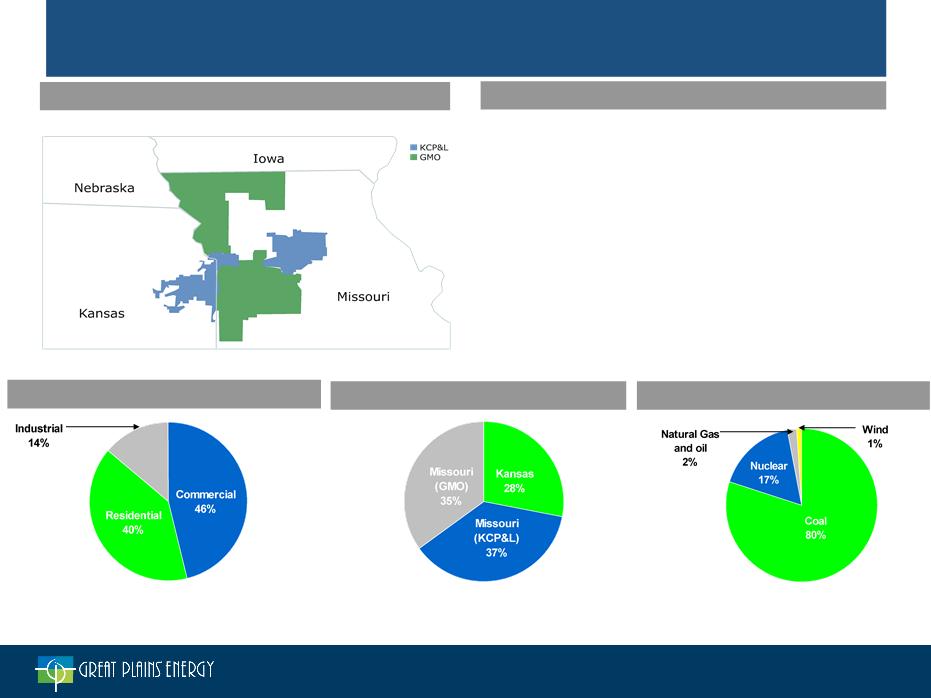
5
September 2011 Investor Presentation
• Solid Midwest electric utility operating under the KCP&L brand
• Transformational events in 2008 to focus business model on fully
regulated utility operations
regulated utility operations
– Sale of Strategic Energy
– Acquisition of Aquila (now KCP&L Greater Missouri Operations
Company, or “GMO”)
Company, or “GMO”)
• Company attributes
– ~825,000 customers / 3,000 employees
– ~6,600 MW of primarily low-cost coal baseload generation
– 5-year projected synergies post-GMO acquisition of ~$760M
– ~$8.8bn in assets at 2010YE
– ~$5.6bn in rate base
Service Territories: KCP&L and GMO
Business Highlights
2010 Retail MWh Sold by Customer Type*
2010 Retail MWh Sales by Jurisdiction*
2010 MWh Generated by Fuel Type*
Total: ~ 23,806 MWhs
Total: ~ 23,806 MWhs
Total: ~ 26,679 MWhs
Solid Vertically-Integrated Midwest Utility
* In thousands

6
September 2011 Investor Presentation
|
Leading Industries
(Employees in 000’s)
|
|
|
State & Local Government
|
124.8
|
|
Full and Limited-Service Restaurants
|
63.3
|
|
General Medical & Surgical Hospitals / Offices of
Physicians |
46.7
|
|
Federal Government
|
29.1
|
|
Employment Services
|
20.6
|
|
Depository Credit Intermediation
|
16.3
|
|
Grocery Stores
|
16.2
|
|
Department Stores
|
15.5
|
|
Computer Systems Design and Related Srvcs
|
15.2
|
|
Management of Companies and Enterprises
|
15.2
|
KC Metropolitan Area Economy - Snapshot
|
Top 10 Employers
(# of Employees)
|
|
|
HCA Midwest Health System
|
8,127
|
|
Wal-Mart Stores, Inc.
|
7,400
|
|
Sprint Corporation
|
7,300
|
|
St. Luke’s Health System
|
6,622
|
|
McDonald’s USA LLC
|
5,700
|
|
Cerner Corporation
|
4,980
|
|
Children’s Mercy Hospital & Clinics
|
4,812
|
|
DST Systems, Inc.
|
4,425
|
|
Truman Medical Center
|
4,081
|
|
University of Kansas Hospital
|
3,880
|
• The Kansas City metro area economy is represented by a diverse set of
industries, supported by a sizeable presence in the governmental sector
industries, supported by a sizeable presence in the governmental sector
Strengths
• Diversified economy
• Stability from governmental sector
• Well-developed transportation &
distribution network
distribution network
• Central national location
• Low cost of living/business
Weaknesses
• Increased competition from other
Midwest business centers
Midwest business centers
• High dependence on Sprint Nextel
and telecom
and telecom
• Suburban sprawl
• Low employment growth
Opportunities
• New Ford product lines create local
jobs
jobs
• Google ultra-high speed fiber
network supports tech economy
network supports tech economy
• Kansas wind power attracts clean-
energy firms
energy firms
Source: The Kansas City Business Journal, BLS and Moody’s Analytics
Source for Listed Attributes: Moody’s Analytics

7
September 2011 Investor Presentation
KC Metropolitan Area Economy - Snapshot
Recent Performance
• Labor market has firmed recently, but recovery remains
sluggish as job growth remains below national and
regional averages (as it has since late 2009)
sluggish as job growth remains below national and
regional averages (as it has since late 2009)
• Expansion is limited to relatively few industries, such as
retail and manufacturing
retail and manufacturing
• Home prices continue to slide and construction is
depressed
depressed
• Nevertheless, the economy is in a better position
compared with six months ago, as the labor market is
no longer deteriorating
compared with six months ago, as the labor market is
no longer deteriorating
Economic Outlook
• Kansas City does not appear to be at a heightened risk
of a second recession as labor market troubles have
mostly ended
of a second recession as labor market troubles have
mostly ended
• Growth remains weak, however, and the recovery is
expected to lag the national expansion in the near-term
expected to lag the national expansion in the near-term
• Later in 2011, however, the recovery is projected to
improve in pace and breadth, expanding beyond
manufacturing and into key service industries
improve in pace and breadth, expanding beyond
manufacturing and into key service industries
• Longer term, low costs and favorable demographic
trends are forecasted to drive solid growth that will
match the U.S. average and outpace that of most
Midwest metro areas
trends are forecasted to drive solid growth that will
match the U.S. average and outpace that of most
Midwest metro areas
*Source: Graphics and text used with
permission from Moody’s Analytics
permission from Moody’s Analytics

8
September 2011 Investor Presentation
Recent Developments and
June 30, 2011 Year-to-Date
Operating & Financial Update
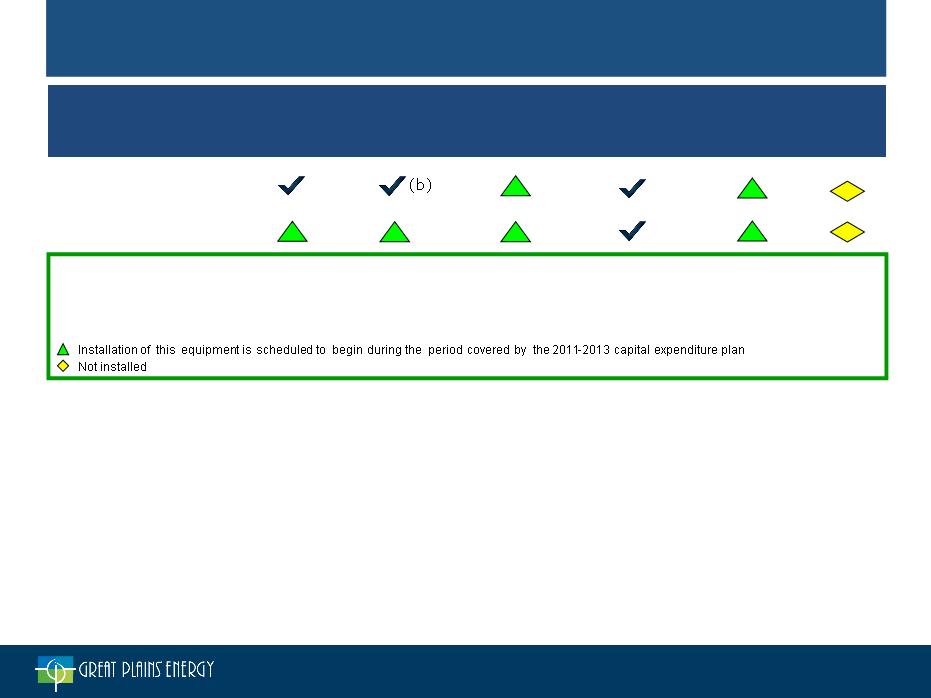
9
September 2011 Investor Presentation
• KCC order stated that the decision to retrofit LaCygne 1 and 2 was
reasonable, reliable, efficient and prudent and the cost estimate is
reasonable
reasonable, reliable, efficient and prudent and the cost estimate is
reasonable
• Total project cost estimate, excluding AFUDC and property tax, of $1.23
billion; KCP&L’s total share is $615 million and Kansas jurisdictional share is
$281 million
billion; KCP&L’s total share is $615 million and Kansas jurisdictional share is
$281 million
• Requested environmental rider denied
• KCP&L has announced plans to proceed with the retrofit of LaCygne
Recent Developments -
Kansas Predetermination
|
Coal Unit
|
MW
|
SCR
|
Scrubber
|
Baghouse
|
Other
Particulate
Control
|
Mercury
Controls |
Cooling
Tower |
|
LaCygne 1
|
368(a)
|
|
|
|
|
|
|
|
LaCygne 2
|
341(a)
|
|
|
|
|
|
|
(a) KCP&L’s share of jointly-owned facility
(b) LaCygne 1 currently has a scrubber installed; however, 2011-13 capital expenditure plan includes the installation of a new scrubber on the unit
(c) Existing scrubber removes particulate matter but will be replaced by the baghouse
(d) Existing precipitator will be replaced by the baghouse
ü Installed
(c)
(d)

10
September 2011 Investor Presentation
Weather-Normalized Year-over-Year
Retail MWh Sales
Retail MWh Sales
1 Drivers contributing to the portion of the YTD decline that occurred in 1Q11 may have included a) switching to natural gas heat; b) conversion to more
efficient heat pumps; c) conservation among KCP&L KS customers on an all-electric rate triggered by a substantial rate increase for this rate class in
KCP&L’s 2010 KS rate case; and d) continued challenges in the local economy
efficient heat pumps; c) conservation among KCP&L KS customers on an all-electric rate triggered by a substantial rate increase for this rate class in
KCP&L’s 2010 KS rate case; and d) continued challenges in the local economy
2 As of June 30
2009
2009
2009
2009
2010
2010
2010
2010
2011 YTD1,2
Residential
Commercial
Industrial
2011 YTD1,2
2011 YTD1,2
2011 YTD1,2
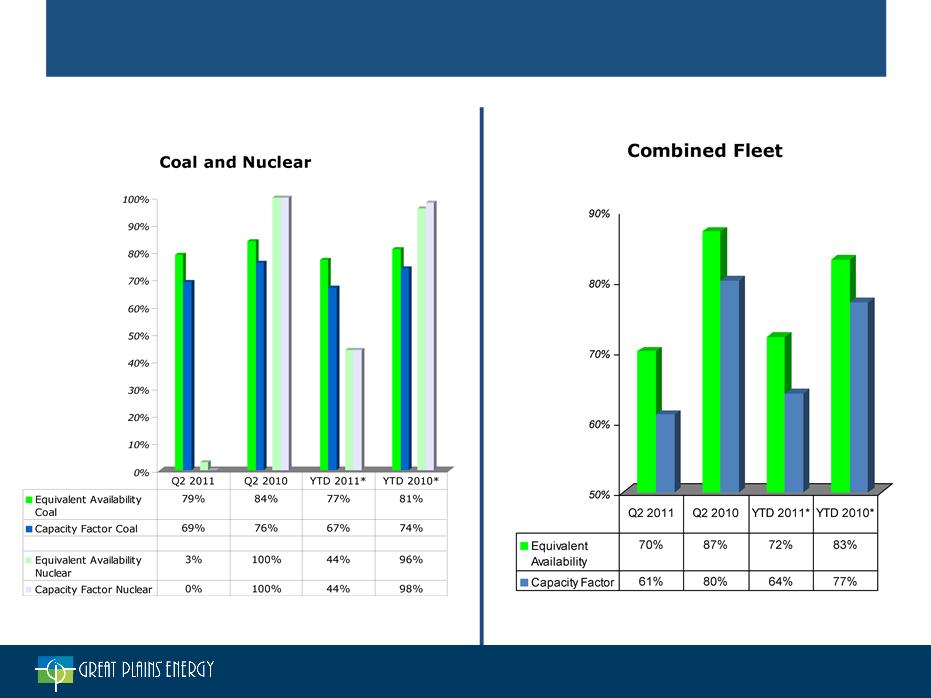
11
September 2011 Investor Presentation
Plant Performance
* As of June 30
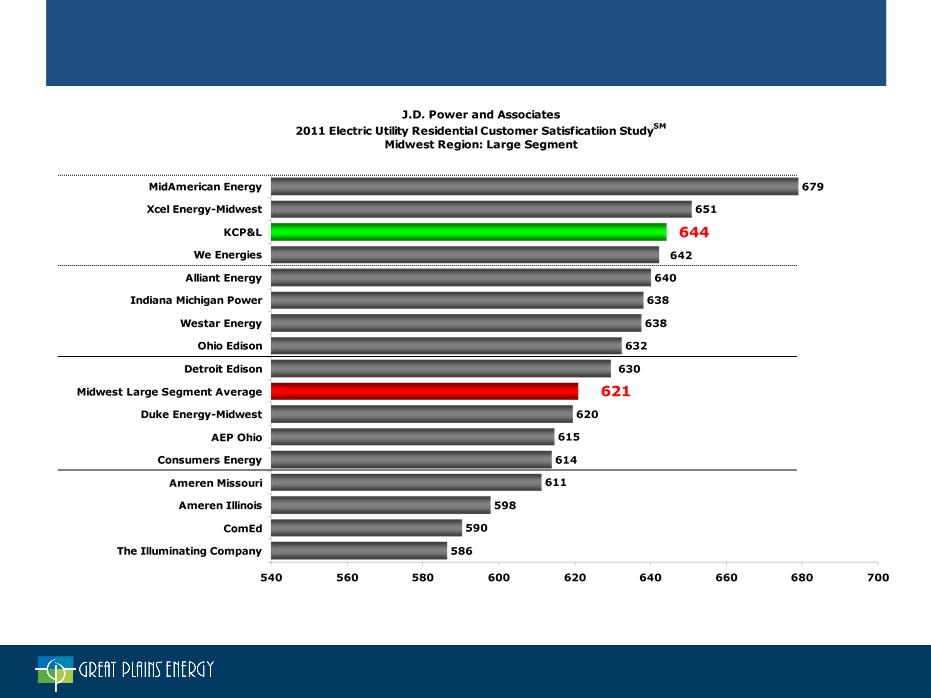
12
September 2011 Investor Presentation
Source: J.D. Power and Associates 2011 Electric Utility Residential Customer Satisfaction StudySM
Tier 1
Tier 2
Tier 3
Tier 4
Customer Satisfaction
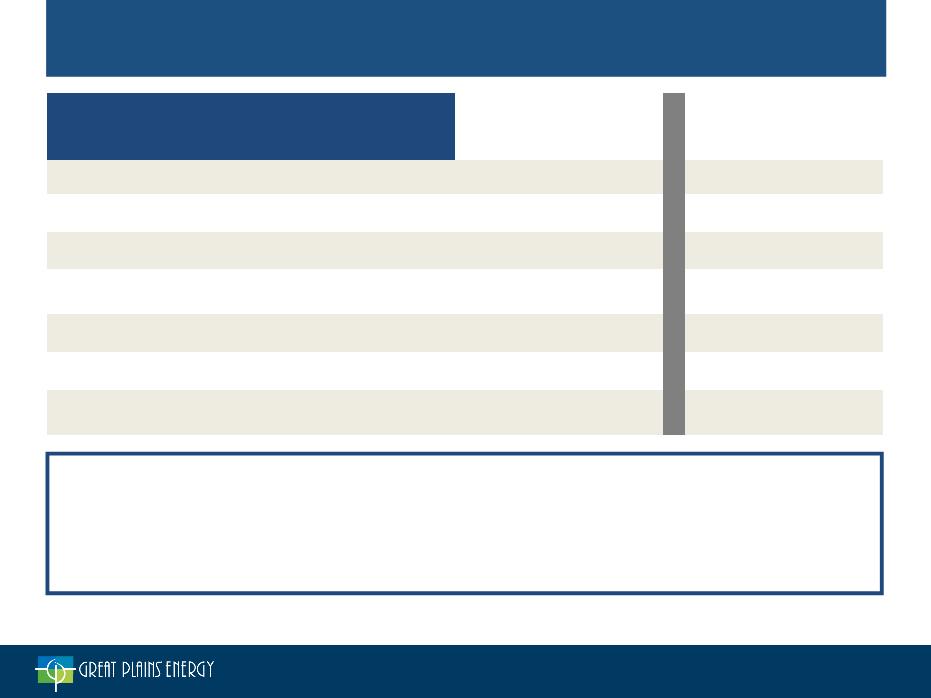
13
September 2011 Investor Presentation
• Electric Utility’s net income decreased $40.6 million including a $22.9 million decrease in gross
margin*
margin*
• Common stock outstanding for the year to date averaged 138.6 million shares, about 1 percent
higher than the same period in 2010
higher than the same period in 2010
|
|
Earnings (in Millions)
|
|
Earnings per Share
|
||
|
|
2011
|
2010
|
|
2011
|
2010
|
|
Electric Utility
|
$ 56.0
|
$ 96.6
|
|
$ 0.40
|
$ 0.71
|
|
Other
|
(10.3)
|
(11.9)
|
|
(0.07)
|
(0.09)
|
|
Net income
|
45.7
|
84.7
|
|
0.33
|
0.62
|
|
Less: Net (income) loss attributable to
noncontrolling interest |
0.1
|
(0.1)
|
|
-
|
-
|
|
Net income attributable to Great Plains Energy
|
45.8
|
84.6
|
|
0.33
|
0.62
|
|
Preferred dividends
|
(0.8)
|
(0.8)
|
|
(0.01)
|
(0.01)
|
|
Earnings available for common shareholders
|
$ 45.0
|
$ 83.8
|
|
$ 0.32
|
$ 0.61
|
Great Plains Energy Consolidated Earnings
and Earnings Per Share - Year to Date June 30
(Unaudited)
and Earnings Per Share - Year to Date June 30
(Unaudited)
*Gross margin a non-GAAP measure that is defined and reconciled to GAAP operating revenues in the Appendix

14
September 2011 Investor Presentation
Electric Utility Year-to-Date June 30 Results
Decreased depreciation and amortization
• Lower regulatory amortization
Decreased income tax expense
• Lower pre-tax income
Increased other operating expenses
• O&M and property taxes related to Iatan 2
• Disallowances and other costs resulting
from MO rate case orders
• Pension expense
Decreased non-operating income and expenses
• Lower AFUDC equity
Charges related to organizational realignment
and voluntary separation program
and voluntary separation program
Key Earnings Drivers
$23.2M Pre-tax
$21.5M
$27.9M Pre-tax
Decreased gross margin*
• Lower weather-normalized demand
• Extended Wolf Creek outage
• Higher coal transportation costs
• Unfavorable weather
• Above factors partially offset by new KCP&L
retail rates
$22.9M Pre-tax
$19.8M Pre-tax
$12.7M Pre-tax
*Gross margin is a non-GAAP measure that is defined and reconciled
to GAAP operating revenues in the Appendix
to GAAP operating revenues in the Appendix

15
September 2011 Investor Presentation
2011 Quarterly and Year-to-Date June 30
EPS Reconciliation Versus 2010
|
|
Special
Factors |
Weather &
WN Demand |
Lag
|
Other
|
Total
|
|
1Q 2011
|
$0.07
|
$0.03
|
$0.04
|
|
$0.14
|
|
2Q 2011
|
$0.06
|
$0.04
|
$0.02
|
$0.04
|
$0.16
|
|
Year To
Date |
$0.13
|
$0.07
|
$0.06
|
$0.03
|
$0.29
|
|
|
2010 EPS
|
2011 EPS
|
Decrease
in EPS |
|
1Q
|
$0.15
|
$0.01
|
$0.14
|
|
2Q
|
$0.47
|
$0.31
|
$0.16
|
|
Year To
Date |
$0.61
|
$0.32
|
$0.29
|
Contributors to Lower 2011 EPS Compared to 2010
Note: Numbers may not add due to the effect of dilutive shares on EPS
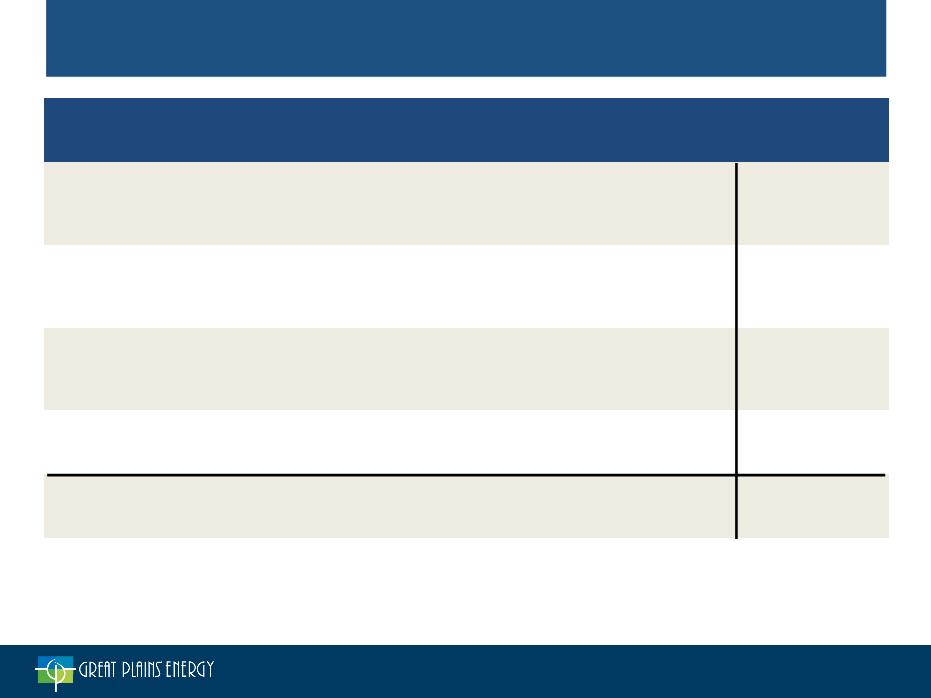
16
September 2011 Investor Presentation
Special Factors Impacting 2011
|
|
1Q
|
2Q
|
2nd Half 2011
Estimate
|
Total
|
|
Disallowances and other
accounting effects from Missouri rate case orders |
[$0.03]
|
|
|
[$0.03]
|
|
Organizational realignment
and voluntary separation program |
[$0.04]
|
[$0.01]
|
|
[$0.05]
|
|
Wolf Creek extended outage
and replacement power |
|
[$0.05]
|
|
[$0.05]
|
|
Coal conservation due to
flooding |
|
|
[$0.10]
|
[$0.10]
|
|
Total
|
[$0.07]
|
[$0.06]
|
[$0.10]
|
[$0.23]
|
(b)
(a)
(a) Range [$0.08] to [$0.12]
(b) Range [$0.21] to [$0.25]
(All Amounts Per-Share)

17
September 2011 Investor Presentation
|
Great Plains Energy Debt
|
||||||||
|
($ in millions)
|
KCP&L
|
GMO (1)
|
GPE
|
Consolidated
|
||||
|
|
Amount
|
Rate(2)
|
Amount
|
Rate(2)
|
Amount
|
Rate(2)
|
Amount
|
Rate(2)
|
|
Short-term debt
|
$ 571.7
|
0.51%
|
$ 65.0
|
2.94%
|
$ 27.0
|
2.94%
|
$ 663.7
|
0.85%
|
|
Long-term debt (3)
|
1,667.4
|
6.22%
|
658.0
|
10.96%
|
986.7
|
6.61%
|
3,312.1
|
7.24%
|
|
Total
|
$2,239.1
|
4.76%
|
$723.0
|
10.21%
|
$1,013.7
|
6.51%
|
$3,975.8
|
6.17%
|
Secured debt = $748.7 (19%), Unsecured debt = $3,227.1 (81%)
(1) GPE guarantees substantially all of GMO’s debt
(2) Weighted Average Rates - excludes premium / discounts and fair market value adjustments; includes full Equity Units coupon (12%) for GPE
(3) Includes current maturities of long-term debt
Long-Term Debt Maturities (4)
Debt Profile as of June 30, 2011
(4) 2013 reflects mode maturity for $167.6 million of KCP&L tax-exempt bonds subject to remarketing prior to final maturity date
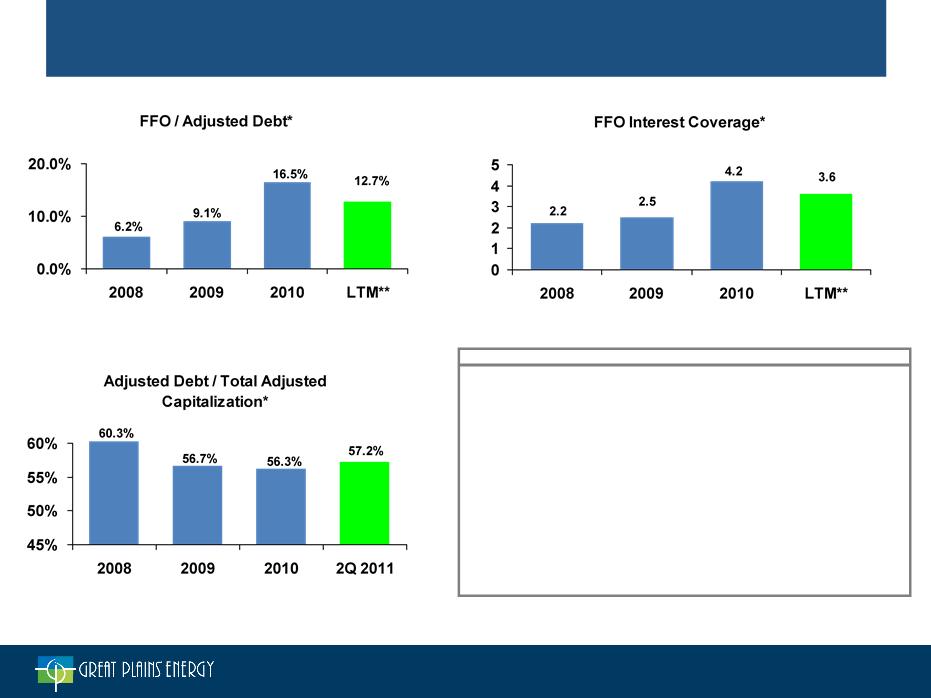
18
September 2011 Investor Presentation
Moody's
Standard & Poor's
Great Plains Energy
Outlook
Stable
Stable
Corporate Credit Rating
-
BBB
Preferred Stock
Ba2
BB+
Senior Unsecured Debt
Baa3
BBB-
KCP&L
Outlook
Stable
Stable
Senior Secured Debt
A3
BBB+
Senior Unsecured Debt
Baa2
BBB
Commercial Paper
P-2
A-2
GMO
Outlook
Stable
Stable
Senior Unsecured Debt
Baa3
BBB
Current Credit Ratings
* All ratios calculated using Standard and Poor’s methodology. Ratios are non-GAAP measures that are defined and reconciled to GAAP in the Appendix
** Last twelve months as of June 30, 2011
Credit Profile for Great Plains Energy

19
September 2011 Investor Presentation
Operations and Regulatory Strategy

20
September 2011 Investor Presentation
Key Themes - Environmental
1. Estimated cost of compliance with current /
proposed legislation = approximately $1 billion:
proposed legislation = approximately $1 billion:
• LaCygne
– Unit 1 (368 MW*) - scrubber and baghouse -
2015
2015
– Unit 2 (341 MW*) - full Air Quality Control
System (“AQCS”) - 2015
System (“AQCS”) - 2015
• Montrose 3 (176 MW) - full AQCS - 2016 (approx.)
• Sibley 3 (364 MW) - scrubber and baghouse - 2016
2. Other retrofits less likely and therefore not
included in estimated cost of compliance:
included in estimated cost of compliance:
• Montrose 1 and 2 (total capacity 334 MW)
• Sibley 1 and 2 (total capacity 102 MW)
• Lake Road 4 and 6 (99 MW)
*KCP&L’s share of jointly-owned facility

21
September 2011 Investor Presentation
Key Themes - Renewable Energy
and Energy Efficiency
1. Future renewable requirements driven by the
following:
following:
– 2007 Collaboration Agreement with Sierra Club
– Renewable Portfolio Standards (“RPS”) in Missouri
and Kansas
and Kansas
2. Flexibility regarding acquisition of future
renewable resources:
renewable resources:
– Through Purchased Power Agreements (“PPAs”)
and purchases of Renewable Energy Credits
(“RECs”); or
and purchases of Renewable Energy Credits
(“RECs”); or
– Adding to rate base if supported by credit profile
and availability of equity financing
and availability of equity financing
3. Energy efficiency expected to be a key
component of future resource portfolio:
component of future resource portfolio:
– Aggressive pursuit planned with appropriate
regulatory recovery
regulatory recovery

22
September 2011 Investor Presentation
Key Themes - Transmission
1. Two significant projects are currently in GXP’s
plans:
plans:
• Iatan-Nashua 345kV line - Projected $54M
total cost and 2015 in-service date
total cost and 2015 in-service date
• Sibley-Maryville-Nebraska City 345kV line -
Projected $380M total cost and 2017 in-
service date
Projected $380M total cost and 2017 in-
service date
2. Increasingly competitive environment requires
consideration of strategic options
consideration of strategic options
3. Flexibility is important - opportunity to pursue
projects unilaterally but also preserve capital if
needed through partnership
projects unilaterally but also preserve capital if
needed through partnership

23
September 2011 Investor Presentation
Key Themes - Plant Operations
1. No additional baseload generation expected for
several years
several years
2. Targeting modest improvements in existing fleet
performance in the coming years
performance in the coming years
3. No changes currently planned regarding nuclear’s
role in the portfolio
role in the portfolio

24
September 2011 Investor Presentation
Key Themes - Regulatory
1. Our rates continue to compare well regionally and
nationally
nationally
2. Over the last five years, the Company has received
fair and constructive treatment in both Kansas and
Missouri, allowing for recovery of our CEP capital
additions
fair and constructive treatment in both Kansas and
Missouri, allowing for recovery of our CEP capital
additions
3. We continue to aggressively pursue strategies to
improve our operating cost structure and are
evaluating the best combination of rate cases and
riders/trackers to reduce regulatory lag while
minimizing the impact on customers
improve our operating cost structure and are
evaluating the best combination of rate cases and
riders/trackers to reduce regulatory lag while
minimizing the impact on customers

25
September 2011 Investor Presentation
2011 - 2012 Earnings
Guidance and 2013 Drivers
Guidance and 2013 Drivers

26
September 2011 Investor Presentation
Focused on Delivering Value to Shareholders
Earnings Growth
Expected Through Reduced Regulatory Lag, Disciplined Cost
Management and Long-Term Rate Base Growth
Management and Long-Term Rate Base Growth
Competitive Dividend
Goal to Maintain Competitive Dividend While Strengthening Key Credit
Metrics; Objective to Grow Dividend In Line With Payout Ratio
Targets
Metrics; Objective to Grow Dividend In Line With Payout Ratio
Targets
Objective: Improved Total Shareholder Returns

27
September 2011 Investor Presentation
Potential Earnings from Regulated Operations
Based on Recent Rate Case Outcomes
Based on Recent Rate Case Outcomes
12012 includes conversion to 17.1M shares of GXP common stock in June

28
September 2011 Investor Presentation
2011 and 2012 Earnings Guidance
2012 Versus 2011 Guidance
(a) Change Due to Additional Shares From Equity Units Converted to GXP Common Stock in June 2012
(b) Impacts of Capital Expenditures and Related AFUDC
(c) Impacts of Additional Plant Placed in Service and Not in Rates
(d) Elimination of 2011 Coal Rail Contract Lag Related to Timing of KCP&L-MO Rate Case
(e) Changes in Property Taxes and Transmission Expenses Covered by Guidance Variability
(f) Assumes NFOM Expense Will Be Managed Within Level of Retail Demand in Rates
(g) Full Year Missouri Rate Cases in Place
(h) Assumes 2011 Special Factors Do Not Impact 2012
(i) No Anticipated Change in Corporate/Shareholder Costs
(j) No Anticipated Change in Non Regulatory Capital Cost
Total Estimated
Regulatory Lag of
Approximately
100 to 200 Basis
Points
Regulatory Lag of
Approximately
100 to 200 Basis
Points

29
September 2011 Investor Presentation
2011 Earnings Guidance Range - $1.10 - $1.25
(a) Year to Date June 2011 Versus Full Year 2010
(b) Weather-Normalized (“WN”) Year to Date June 2011 Versus Year to Date June 2010
(All Amounts Per-Share)

30
September 2011 Investor Presentation
2012 Earnings Guidance Range - $1.35 - $1.55
(All Amounts Per-Share)

31
September 2011 Investor Presentation
• Target is 50 basis points of lag in regulated operations in 2013 (compared
to approximately 100-200 basis points reflected in 2012 guidance)
to approximately 100-200 basis points reflected in 2012 guidance)
• Strategies to reduce lag in 2013 are 1) operational and 2) regulatory
– Operational
• High level of system reliability and plant performance
• Continue baseline assumption that changes in NFOM and weather-normalized load are
offsetting
offsetting
• Aggressively manage NFOM as close to allowed level in rates as possible
– Demand growth would potentially create earnings upside
• Increased AFUDC from environmental and other capital projects
– Regulatory
• Currently-expected rate cases and/or riders & trackers:
– Rate cases - present view contemplates filing to achieve new rates effective beginning of 2013
– Riders & Trackers - initial focus on property taxes and transmission expenses
• Other drivers
– Weighted average shares - increase to 154M with full-year impact from Equity
Units conversion
Units conversion
– Other impacts from Equity Units conversion
• ROE benefit from additional equity in capital structure largely offset by significantly lower
interest expense on Equity Units’ remarketed debt
interest expense on Equity Units’ remarketed debt
– Full-year impact from refinancing GMO high-coupon debt
• Expected to be negative in terms of GAAP interest expense
2013 Projected Drivers

32
September 2011 Investor Presentation
Rate Base Growth
*In Progress includes:
• Plant in service but not in rates
• Construction Work In Progress, including environmental and transmission projects
• Changes in deferred income taxes, including book-versus-tax differences and bonus depreciation
Projected Year End Balances
Remaining Iatan 2
(MO/KS),
(MO/KS),
Spearville 2 (KS),
Other
LaCygne
Env,
Env,
Trans,
Other
In Current Rates

33
September 2011 Investor Presentation
• Strong emphasis on improving credit metrics
– Objective is visibility to sustainable FFO / Adjusted Debt* of 16%+
beginning in 2012
beginning in 2012
• Dividend is reviewed quarterly in context of this objective as well as a
belief that a sustainable and increasing dividend is a key driver of TSR
and therefore a desirable goal
belief that a sustainable and increasing dividend is a key driver of TSR
and therefore a desirable goal
• Target payout ratio remains 50-70%
Dividend Strategy Considerations
Competitive Dividend
Goal to Maintain Competitive Dividend While Strengthening Key Credit
Metrics; Objective to Grow Dividend In Line With Payout Ratio
Targets
Metrics; Objective to Grow Dividend In Line With Payout Ratio
Targets
• Company’s objective is to create shareholder value through
– Increased earnings from reduced lag, disciplined cost management and long
-term asset growth
-term asset growth
– A competitive dividend that complements this growth platform
*FFO / Adjusted Debt is a non-GAAP measure that is defined in the Appendix

34
September 2011 Investor Presentation
GXP - A Compelling Investment Thesis
• Proven track record of constructive regulatory treatment
• Credibility with regulators in terms of planning and execution of large, complex projects
• Competitive retail rates on a regional and national level supportive of potential future
investment
investment
Diligent
Regulatory
Approach
Regulatory
Approach
• Target significant reduction in regulatory lag
• Seek to deliver earnings growth and increasing and sustainable cash dividends as a key
component of Total Shareholder Return (“TSR”)
component of Total Shareholder Return (“TSR”)
• Priority to improve / stabilize key credit metrics
Focused on
Shareholder
Value Creation
Shareholder
Value Creation
Excellent
Relationships
with Key
Stakeholders
Relationships
with Key
Stakeholders
• Customers - Tier 1 customer satisfaction
• Suppliers - strategic supplier alliances focused on long-term supply chain value
• Employees - strong relations between management and labor (3 IBEW locals)
• Communities - leadership, volunteerism and high engagement in the areas we serve
• Environmental - additional ~$1 billion of “High Likelihood” capital projects planned to
comply with existing / proposed environmental rules
comply with existing / proposed environmental rules
• Transmission - additional $0.4 billion of capital additions planned
• Renewables - driven by Collaboration Agreement and MO/KS RPS; potential capital
additions if attractive equity financing is available
additions if attractive equity financing is available
• Other Growth Opportunities - selective future initiatives that will leverage our core
strengths
strengths
Attractive
Platform for
Long-Term
Growth
Platform for
Long-Term
Growth

35
September 2011 Investor Presentation
Great Plains Energy
Investor Presentation
September 2011

36
September 2011 Investor Presentation
Appendix

37
September 2011 Investor Presentation
Gross margin is a financial measure that is not calculated in accordance with generally accepted accounting
principles (GAAP). Gross margin, as used by Great Plains Energy, is defined as operating revenues less fuel,
purchased power and transmission of electricity by others. The Company’s expense for fuel, purchased
power and transmission of electricity by others, offset by wholesale sales margin, is subject to recovery
through cost adjustment mechanisms, except for KCP&L’s Missouri retail operations. As a result, operating
revenues increase or decrease in relation to a significant portion of these expenses. Management believes
that gross margin provides a more meaningful basis for evaluating the Electric Utility segment’s operations
across periods than operating revenues because gross margin excludes the revenue effect of fluctuations in
these expenses. Gross margin is used internally to measure performance against budget and in reports for
management and the Board of Directors. The Company’s definition of gross margin may differ from similar
terms used by other companies. A reconciliation to GAAP operating revenues is provided in the table above.
principles (GAAP). Gross margin, as used by Great Plains Energy, is defined as operating revenues less fuel,
purchased power and transmission of electricity by others. The Company’s expense for fuel, purchased
power and transmission of electricity by others, offset by wholesale sales margin, is subject to recovery
through cost adjustment mechanisms, except for KCP&L’s Missouri retail operations. As a result, operating
revenues increase or decrease in relation to a significant portion of these expenses. Management believes
that gross margin provides a more meaningful basis for evaluating the Electric Utility segment’s operations
across periods than operating revenues because gross margin excludes the revenue effect of fluctuations in
these expenses. Gross margin is used internally to measure performance against budget and in reports for
management and the Board of Directors. The Company’s definition of gross margin may differ from similar
terms used by other companies. A reconciliation to GAAP operating revenues is provided in the table above.
Great Plains Energy Reconciliation of
Gross Margin to Operating Revenues
(Unaudited)
Gross Margin to Operating Revenues
(Unaudited)
|
(millions)
|
Three Months Ended June 30
|
Year to Date June 30
|
||
|
|
2011
|
2010
|
2011
|
2010
|
|
Operating revenues
|
$ 565.1
|
$ 552.0
|
$ 1,058.0
|
$ 1,058.9
|
|
Fuel
|
(114.4)
|
(104.1)
|
(219.3)
|
(205.9)
|
|
Purchase power
|
(55.4)
|
(37.9)
|
(110.3)
|
(103.4)
|
|
Transmission of electricity by others
|
(7.0)
|
(7.2)
|
(14.5)
|
(12.8)
|
|
Gross margin
|
$ 388.3
|
$ 402.8
|
$ 713.9
|
$ 736.8
|

38
September 2011 Investor Presentation
Credit Metric Reconciliation to GAAP
Funds from operations (FFO) to adjusted debt is a
financial measure that is not calculated in
accordance with generally accepted accounting
principles (GAAP). FFO to adjusted debt, as used
by Great Plains Energy, is defined in accordance
with Standard & Poor’s methodology used for
calculating FFO to debt. The numerator of the ratio
is defined as net cash from operating activities
(GAAP) plus non-GAAP adjustments related to
operating leases, hybrid securities, post-retirement
benefit obligations, capitalized interest, power
purchase agreements, asset retirement obligations,
changes in working capital and decommissioning
fund contributions. The denominator of the ratio is
defined as the sum of debt balances (GAAP) plus
non-GAAP adjustments related to some of the same
items adjusted for in the numerator and other
adjustments related to securitized receivables and
accrued interest. Management believes that FFO to
adjusted debt provides a meaningful way to better
understand the Company’s credit profile. FFO to
adjusted debt is used internally to help evaluate the
possibility of a change in the Company’s credit
rating.
financial measure that is not calculated in
accordance with generally accepted accounting
principles (GAAP). FFO to adjusted debt, as used
by Great Plains Energy, is defined in accordance
with Standard & Poor’s methodology used for
calculating FFO to debt. The numerator of the ratio
is defined as net cash from operating activities
(GAAP) plus non-GAAP adjustments related to
operating leases, hybrid securities, post-retirement
benefit obligations, capitalized interest, power
purchase agreements, asset retirement obligations,
changes in working capital and decommissioning
fund contributions. The denominator of the ratio is
defined as the sum of debt balances (GAAP) plus
non-GAAP adjustments related to some of the same
items adjusted for in the numerator and other
adjustments related to securitized receivables and
accrued interest. Management believes that FFO to
adjusted debt provides a meaningful way to better
understand the Company’s credit profile. FFO to
adjusted debt is used internally to help evaluate the
possibility of a change in the Company’s credit
rating.
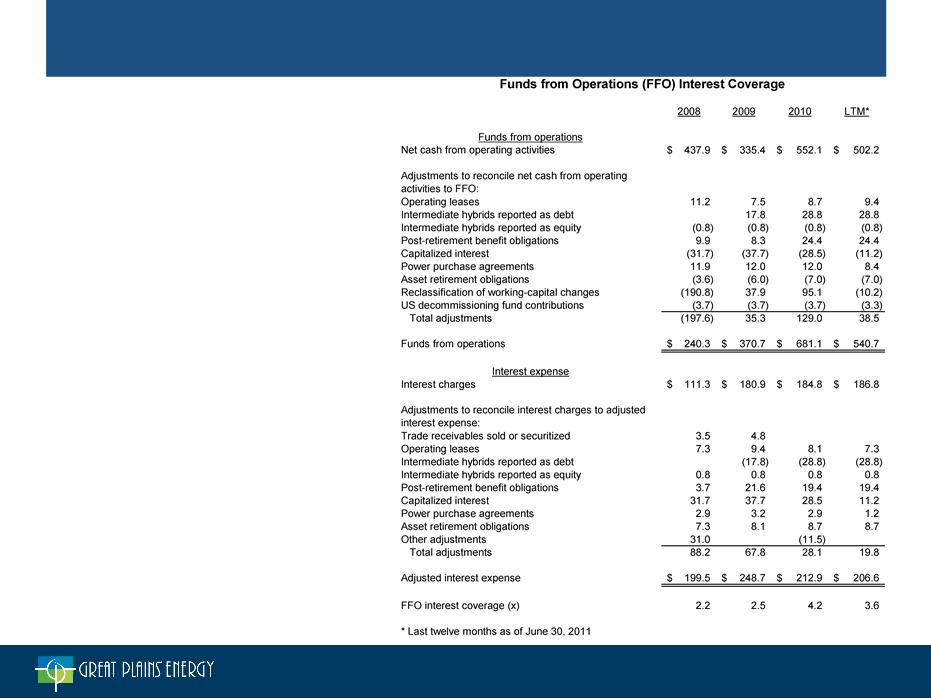
39
September 2011 Investor Presentation
Credit Metric Reconciliation to GAAP
Funds from operations (FFO) interest coverage
ratio is a financial measure that is not calculated
in accordance with generally accepted accounting
principles (GAAP). FFO interest coverage, as
used by Great Plains Energy, is defined in
accordance with Standard & Poor’s methodology
used for calculating FFO interest coverage. The
numerator of the ratio is defined as net cash from
operating activities (GAAP) plus non-GAAP
adjustments related to operating leases, hybrid
securities, post-retirement benefit obligations,
capitalized interest, power purchase agreements,
asset retirement obligations, changes in working
capital and decommissioning fund contributions
plus adjusted interest expense (non-GAAP). The
denominator of the ratio, adjusted interest
expense, is defined as interest charges (GAAP)
plus non-GAAP adjustments related to some of
the same items adjusted for in the numerator and
other adjustments needed to match Standard &
Poor’s calculation. Management believes that
FFO interest coverage provides a meaningful way
to better understand the Company’s credit profile.
FFO interest coverage is used internally to help
evaluate the possibility of a change in the
Company’s credit rating.
ratio is a financial measure that is not calculated
in accordance with generally accepted accounting
principles (GAAP). FFO interest coverage, as
used by Great Plains Energy, is defined in
accordance with Standard & Poor’s methodology
used for calculating FFO interest coverage. The
numerator of the ratio is defined as net cash from
operating activities (GAAP) plus non-GAAP
adjustments related to operating leases, hybrid
securities, post-retirement benefit obligations,
capitalized interest, power purchase agreements,
asset retirement obligations, changes in working
capital and decommissioning fund contributions
plus adjusted interest expense (non-GAAP). The
denominator of the ratio, adjusted interest
expense, is defined as interest charges (GAAP)
plus non-GAAP adjustments related to some of
the same items adjusted for in the numerator and
other adjustments needed to match Standard &
Poor’s calculation. Management believes that
FFO interest coverage provides a meaningful way
to better understand the Company’s credit profile.
FFO interest coverage is used internally to help
evaluate the possibility of a change in the
Company’s credit rating.

40
September 2011 Investor Presentation
Credit Metric Reconciliation to GAAP
Adjusted debt to total adjusted capitalization is
a financial measure that is not calculated in
accordance with generally accepted accounting
principles (GAAP). Adjusted debt to total
adjusted capitalization, as used by Great Plains
Energy, is defined in accordance with Standard
& Poor’s methodology used for calculating the
ratio of debt to debt and equity. The numerator
of the ratio, adjusted debt, is defined as the
sum of debt balances (GAAP) plus non-GAAP
adjustments related to securitized receivables,
operating leases, hybrid securities, post-
retirement benefit obligations, accrued interest,
power purchase agreements and asset
retirement obligations. The denominator of the
ratio, total adjusted capitalization, is defined as
the sum of equity balances (GAAP) plus non-
GAAP adjustments related to hybrid securities
plus the non-GAAP adjusted debt as defined for
the numerator. Management believes that
adjusted debt to total adjusted capitalization
provides a meaningful way to better understand
the Company’s credit profile. Adjusted debt to
total adjusted capitalization is used internally to
help evaluate the possibility of a change in the
Company’s credit rating.
a financial measure that is not calculated in
accordance with generally accepted accounting
principles (GAAP). Adjusted debt to total
adjusted capitalization, as used by Great Plains
Energy, is defined in accordance with Standard
& Poor’s methodology used for calculating the
ratio of debt to debt and equity. The numerator
of the ratio, adjusted debt, is defined as the
sum of debt balances (GAAP) plus non-GAAP
adjustments related to securitized receivables,
operating leases, hybrid securities, post-
retirement benefit obligations, accrued interest,
power purchase agreements and asset
retirement obligations. The denominator of the
ratio, total adjusted capitalization, is defined as
the sum of equity balances (GAAP) plus non-
GAAP adjustments related to hybrid securities
plus the non-GAAP adjusted debt as defined for
the numerator. Management believes that
adjusted debt to total adjusted capitalization
provides a meaningful way to better understand
the Company’s credit profile. Adjusted debt to
total adjusted capitalization is used internally to
help evaluate the possibility of a change in the
Company’s credit rating.
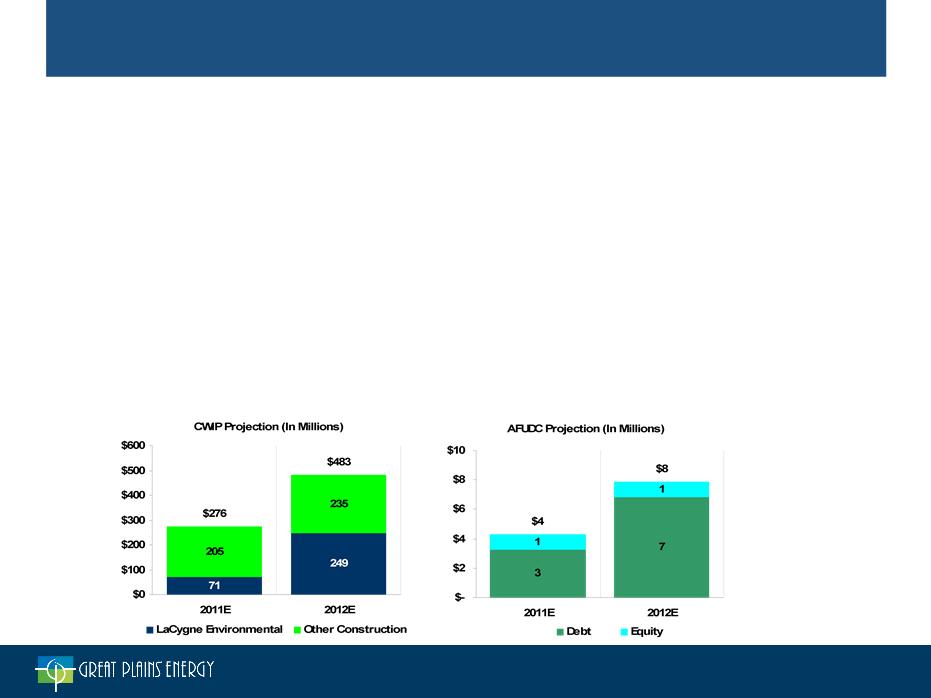
41
September 2011 Investor Presentation
Guidance Assumptions - Depreciation, Bonus
Depreciation, CWIP, AFUDC
Depreciation, CWIP, AFUDC
• Depreciation and Amortization
• KCP&L-MO regulatory amortization of $3.5M/month ended May 2011
• KS Iatan 2 depreciation for full year 2011 and 2012
• MO Iatan 2 traditional depreciation for partial year 2011, full year 2012
• KCP&L began in May 2011, GMO began in June 2011
• Change in depreciation rates from rate case orders
• Depreciation growing for plant placed in service and not in current rates
• Bonus depreciation of approximately $300M in 2011 and $200M in 2012
• Construction Work in Progress (CWIP) / Accumulated Funds Used During
Construction (AFUDC)
Construction (AFUDC)
